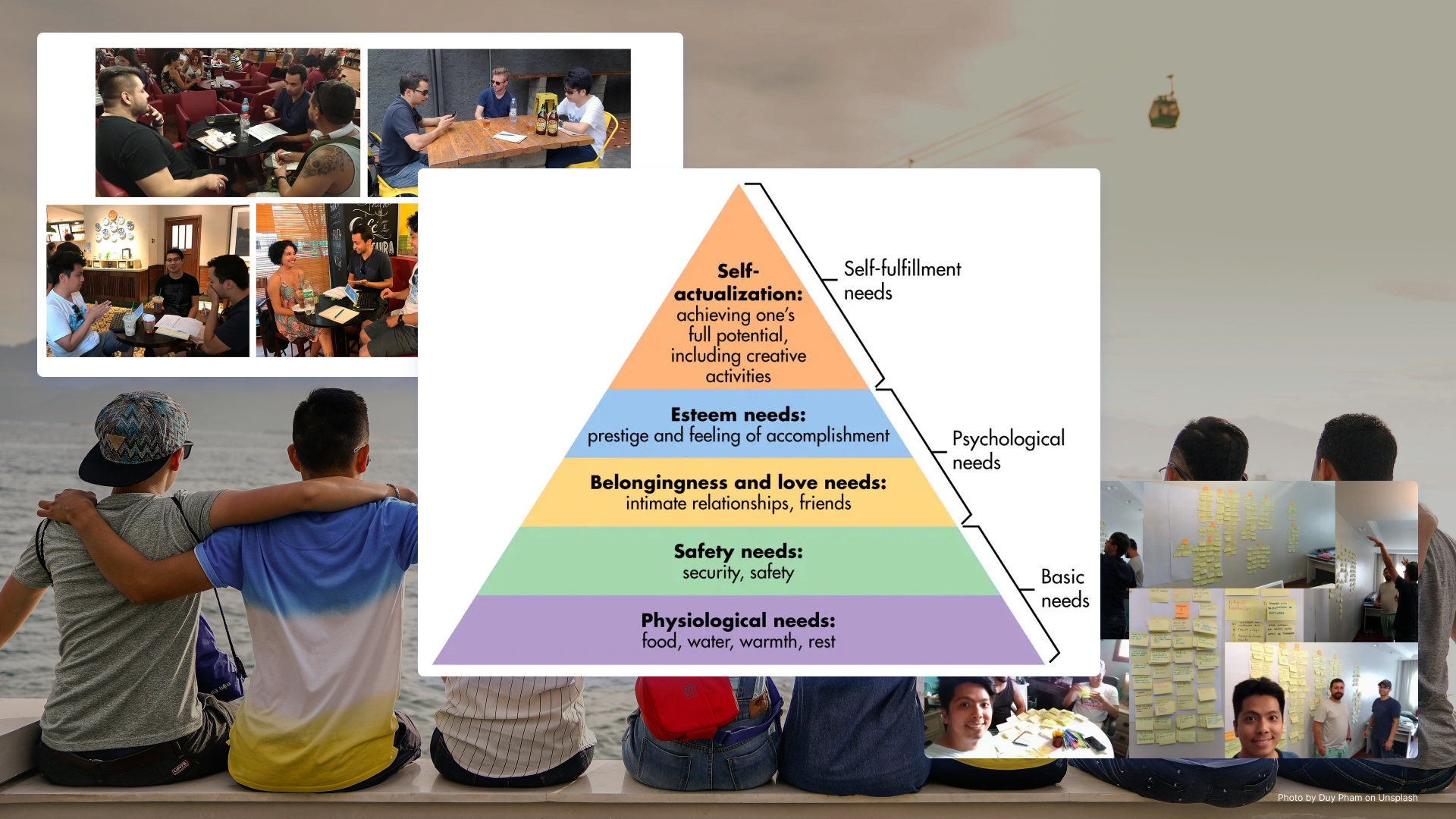The process behind Design Thinking

Introduction
In this post I explain the approach I adopt when developing a project. I can already say that this is nothing new, as it is practically the way I understood Design Thinking (Double Diamond). I leave this post open for discussion and exchange of knowledge.
The Double Diamond
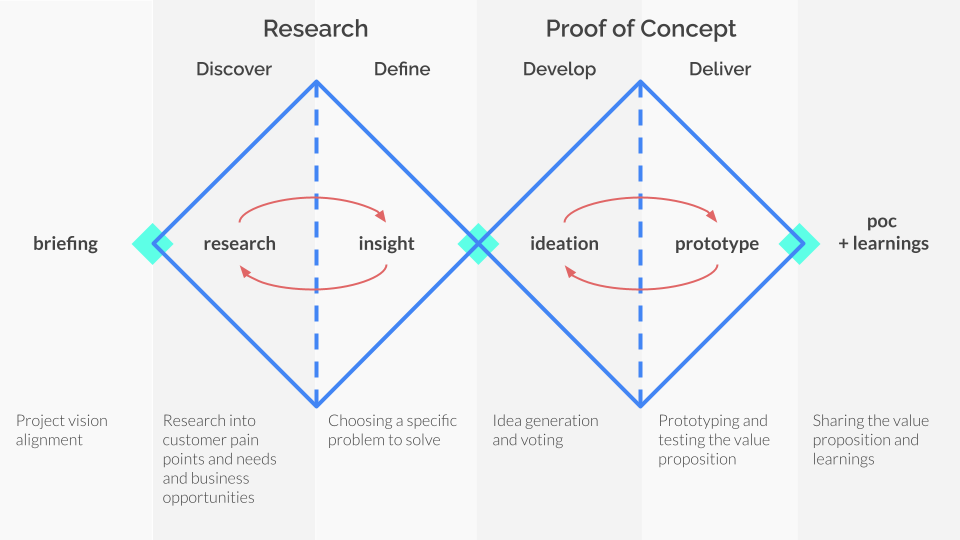
It is an approach that can be used to develop projects. However, what differentiates it from other approaches? The difference lies in its phases (Discover, Define, Develop and Deliver), which are always centered on the user of your product or service. In other words, whenever we move forward with the development of the project, we must keep in mind whether or not what we want to implement will cause friction with the user. It is worth remembering that each phase can involve different tools and methods that, in general, have their purpose, depending on the type of project.
In addition, the approach is neither definitive nor linear, because whenever a new discovery is made, we can go back to the previous steps to update our beliefs. This is not bad, because it allows us to improve our solution to the problem.
Design Thinking is often called Double Diamond (see the diamonds in the diagram that represents it) and is an approach that can be adopted as a basis and from it we can derive new steps, adapt and modify to better fit the context of the project.
In the next sections I will explain each of the phases and the tools and methods I usually use.
Briefing
This is the initial phase of the project. In it, we only have an idea of the problem we want to solve.
Identifying the business area problem
Before we want to jump into user research, it is necessary to understand the business context in which the project is inserted. Therefore, we need to understand the business problem that the project will solve. In this way, we can interview stakeholders to better understand the following points (not limited to):
- What is the context of the problem?
- Who and what is affected by the problem?
- Why do you believe this problem exists?
- What business objective are you trying to solve?
- What is the macro class of the problem? Awareness, Revenue, Automation or other?
- Who are our customers?
- Who are the users most affected by the problem? Why?
- How are the processes of the problem in question related?
- What are the variables involved in the problem?
- What are the biggest challenges for the area of each stakeholder involved in the problem? Why?
- What does each stakeholder define as project success? Why?
- How will success be measured? Why?
Value Assurance
This item is very important and is done together with stakeholders to understand the size of the opportunity of the problem we want to solve, in addition to ensuring the continuity of the initiative. In addition, we can use it as a metric to be measured over time as we complete each cycle, each Sprint. Thus, we can measure it in monetary units so that the numbers are a way of making clear and transparent what we want with this initiative.
You can check out more questions that we can also ask stakeholders in this excellent article by Garrett Kroll. Where he shows 100 questions that every Designer should ask during a project. I recommend reading it!
Discover
The objective of this phase is to identify and understand the pain points and needs of users and, based on these, identify business opportunities. To do this, we can use several research methods, and here I briefly explain some of them.
User Research
Once we have understood the entire context, we can move on to exploring the users’ universe. One of the methods that can help us understand this better from the users’ point of view is Research, which can be quantitative or qualitative and, depending on the project, we can use just one type of research or both.
Quantitative Research
It is usually applied through a survey form and can be used when you want to have an overview of quantity, proportion, relationship between numerical quantities, or an overview of a certain behavior. Example: We want to know what proportion of people who use the subway in the city of São Paulo go to the Center, South Zone, East Zone, North Zone and West Zone in a period of 8 hours. A possible result could be shown as a graph.
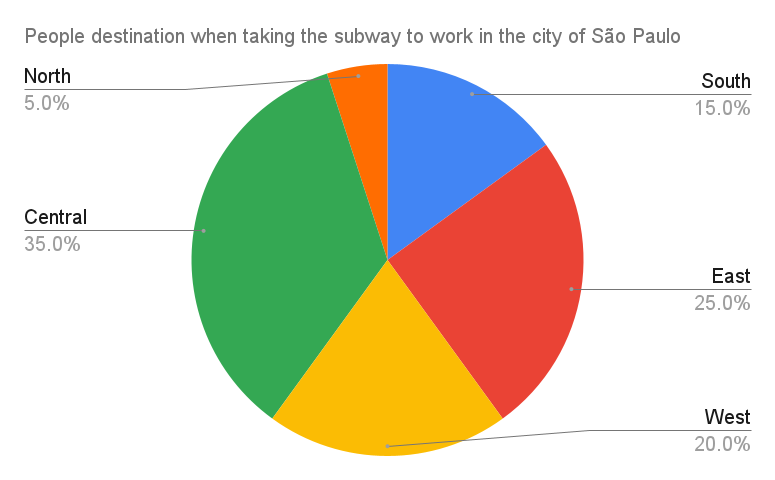
Additionally, if you have access to Dashboards and Reports that someone else has built, use them as a source to complement your research. Below is an example of a retail sales Dashboard that could be used to complement a survey to be conducted with customers in a large market in the sector through Data Analysis.
Qualitative Research
It is usually applied in the form of in-depth interviews where we talk directly to users, either in person or via video call. Empathy is very important in these conversations. To conduct an interview, it is recommended to create a script of questions, so that both the interviewer and the interviewee do not get lost in the conversation. An example of a script can be found in this post in which I talk about interviews and personas that I created for my personal project.
Define
The Discover stage provides us with a lot of information and, from this, we need to extract insights, that is, we need to be able to draw conclusions and motivations that can help us better define the problem so that we can propose the most assertive solution for it.
Therefore, from the data we collected in the previous stage (user interviews, surveys using forms, research in articles and specialized websites, internal data already existing within the company, etc.), we can group (cluster) similar data to transform it into information.
One way to facilitate grouping is to extract keywords or short phrases from the data and write them on post-its, and then group them.

After grouping, one of the tools that can help us consolidate insights is Persona. With it, we can understand who our user is, their pain points, needs, and who we are proposing the solution to. If you want to know a little more about Personas and how to build one, I wrote a post about the context of a personal project here.
In addition, another tool we can use is the Empathy Map, which helps us put ourselves in the users’ shoes and understand them more deeply from different perspectives:
- Who they are
- What they need to do
- What they see
- What they say
- What they do
- What they hear
- What they think and feel
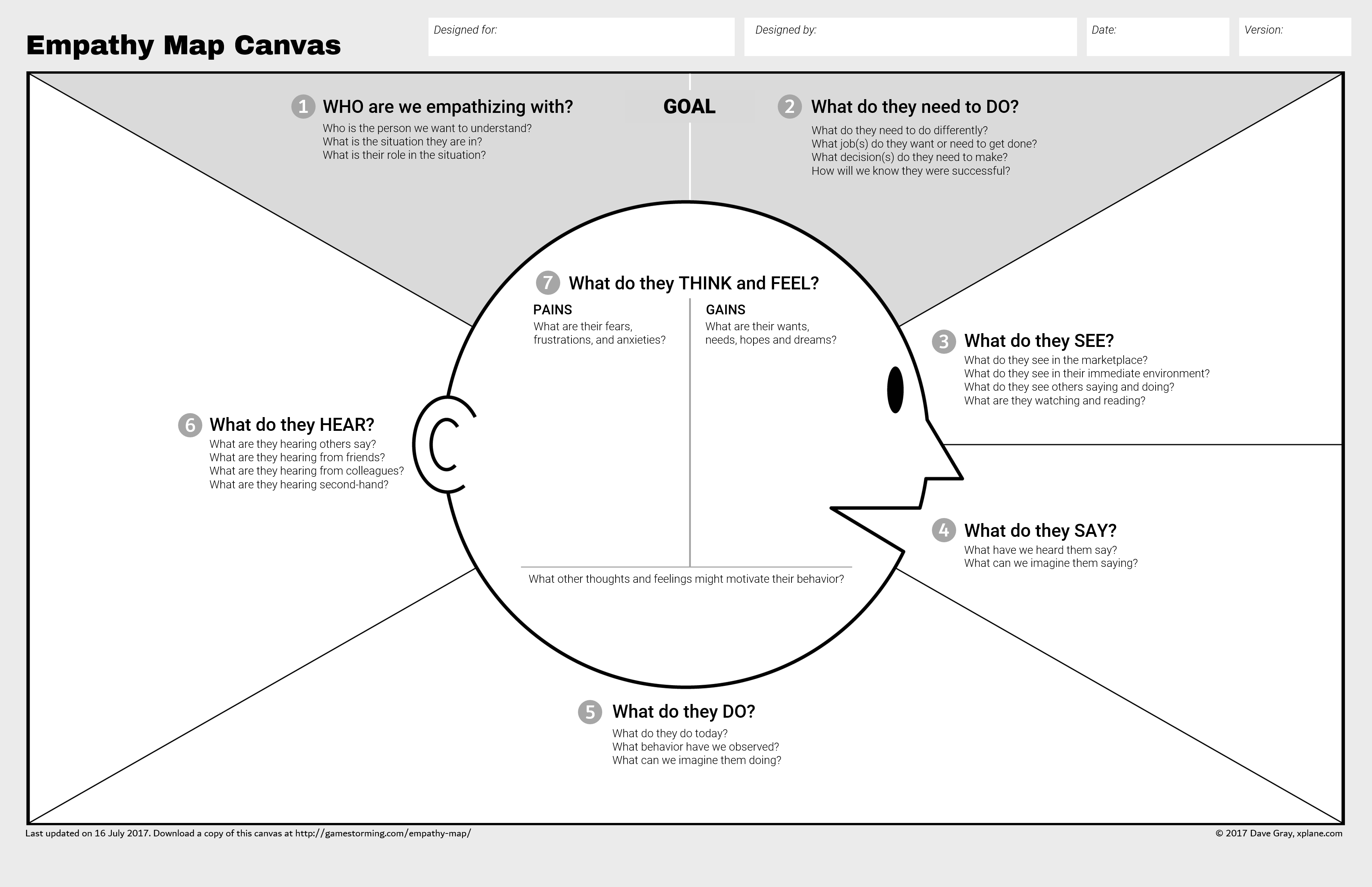
Photo credit: David Gray, Gamestorming, Empathy Map Canvas, http://gamestorming.com/wp-content/uploads/2017/07/Empathy-Map-006-PNG.png
It is worth remembering that the Definition phase is crucial, because if we define the problem incorrectly, our solution will also be incorrect. In other words, even if it is a great solution for a given problem, it may not be meeting the needs of the user and the project’s objective will not have been achieved.
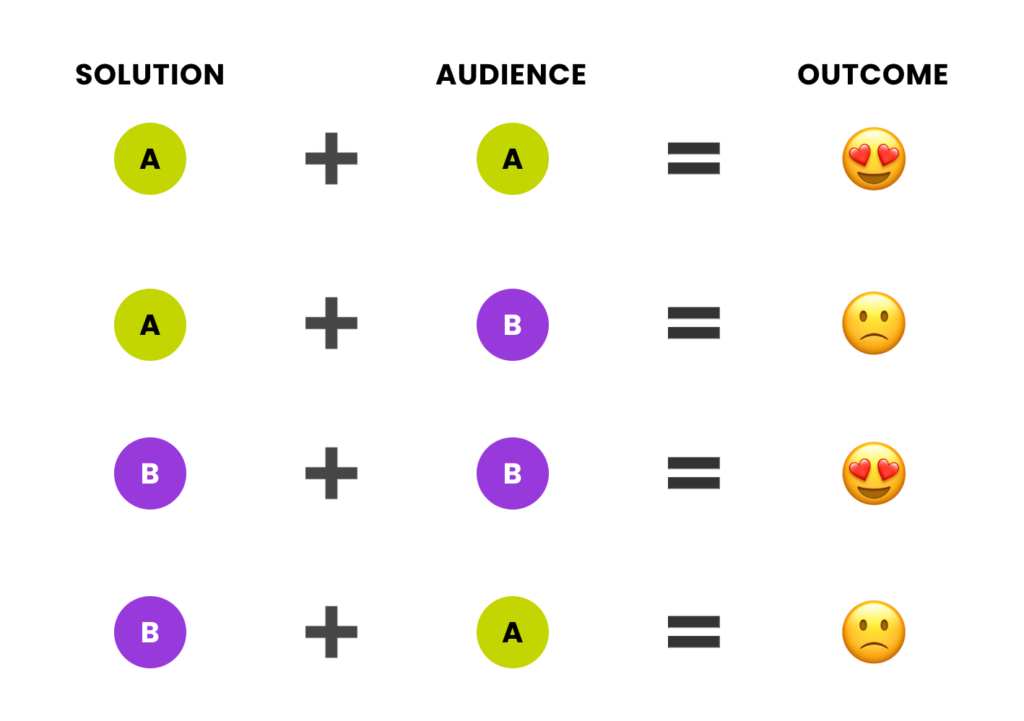
So, once we have defined the problem and who we are proposing the solution for, we can move on to the next stage of the project.
Insights
Here, a parenthesis that I open about insights.
We should not confuse insight with an idea. Insight is not divine light or a flash of the mind.
Insight goes beyond the observed fact. In fact, it is what is behind the fact. The root reason for the observed fact, that is, the reason for that.
An example
Jane is a young woman who works in a company and lives in an apartment in a large metropolis.
Observed fact: Every day Jane waters her plants before going to work.
Insight: Jane waters her plants first thing in the morning because she feels that by doing so she is contributing to something positive and gives her energy to start the day.
Develop
This is the time to generate ideas for solutions to the defined problem. At this stage, it is very important to involve the project stakeholders and subject matter experts, as they can help us come up with solutions with very interesting proposals.
As a result, we can come up with many ideas, but what now? Which one or ones should we choose to move forward with? The choice depends on the scope, budget and time of the project.
We generally use two methods to help stakeholders choose and prioritize ideas.
Importance Matrix
Since the ideas will be recorded on post-its, we can map them as follows.
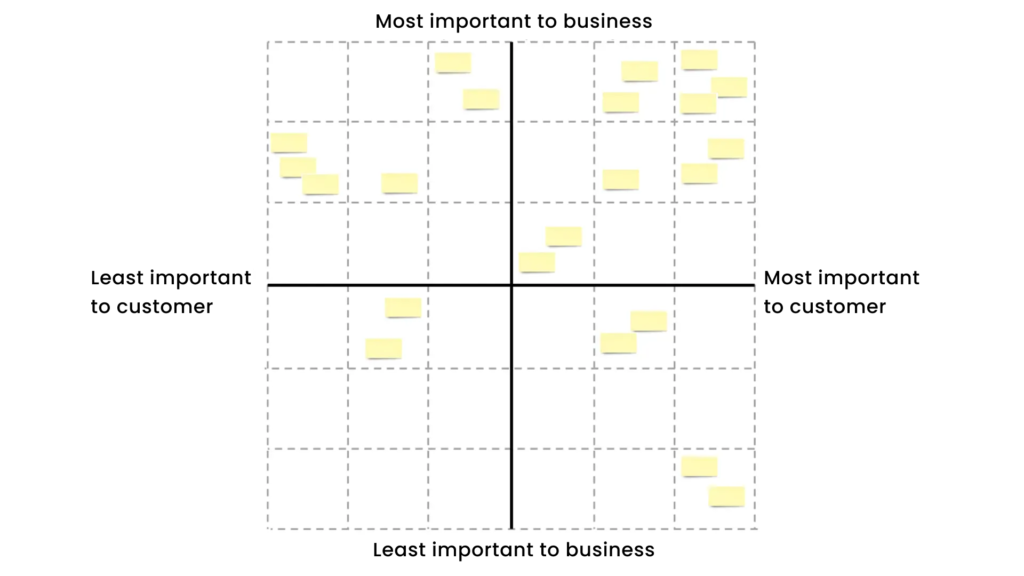
Prioritization Matrix
As the ideas will be recorded on post-its, we can map them as follows.
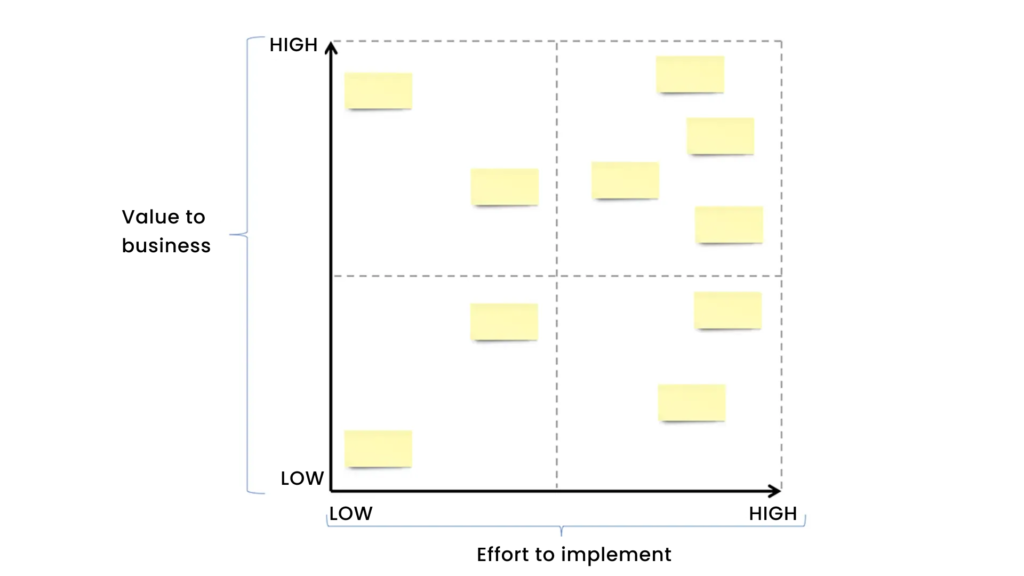
Recording ideas on post-its on a wall helps everyone in the co-creation session with stakeholders to visualize them and makes it easier to decide which ones to choose.
Deliver
After classifying and prioritizing ideas, we need to validate them with users. The methods that help us with this are Prototyping and User Testing.
Prototyping tools range from pencil and paper — and other analog materials — to digital applications (e.g. Figma, Sketch, Atomic.io, Adobe XD, etc.) and, depending on the characteristics of the project, the prototype can be low, medium or high fidelity.
The prototype serves to validate an idea. This way, we can check whether the proposed solution is compliant through usability testing with users and collect feedback on the prototype.
User feedback is important because it allows us to identify various problems in the proposed solution and correct them so that it becomes more compliant with the needs and expectations of users.
By analyzing the feedback, it is possible to check whether the proposed solution idea is the one that will actually meet the needs of users.
Below is a user test carried out using a paper prototype to quickly test and validate our value proposition for a project on dietary restrictions. You can check out all the documentation, findings and the high-fidelity prototype we made for this project in this case study.
If some features are not meeting the needs, this means that the chosen path was not that one, what now? What to do?
Remember that I mentioned that the process is not linear? So, depending on the project schedule, we can make some decisions.
a) If we have time available in the schedule, we can go back to some stages of our process to re-evaluate and even re-ideate the proposed solutions, prototype and test.
b) If we do not have time available, we can just apply the necessary changes to the prototype based on the feedback we gathered from users and test with another set of users.
And then? (POC + Learnings)

Some companies I worked for adopted the Lean Startup methodology. This way, once an idea was validated, the Agile construction flow followed (most of the time using Scrum) and the Growth of the product or service.
Final Considerations
This is the design process that I follow during the development of most of my personal projects, in companies and with clients. It is what I understood about Design Thinking and I know that I still need to learn many aspects of the approach so that I can manipulate it and adapt it better for each type of project.
In addition, I understand and know that there are many other methods that could have been used in each of the phases. The main reason why I chose the ones I mentioned was the ease of use and the level of information they provide me within the context of the project.
Conclusion
The Design Thinking process, as outlined in this article, provides a structured and user-centric approach to problem-solving. By following the Double Diamond model and incorporating various tools and methods, you can develop innovative and effective solutions that meet the needs of your target users.
Remember, the key to successful Design Thinking is a relentless focus on understanding your users, iterating on your ideas, and continuously testing and refining your solutions. By embracing this approach, you can create products and services that truly resonate with your audience and drive positive outcomes.





